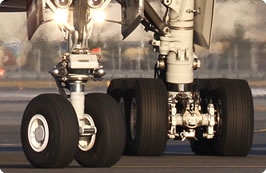
Airplane brakes are very similar to car brakes, though obviously on a larger and more complex scale. There are different types of brakes for different airplanes, but the basic parts are the following: master cylinder (hydraulic valve), rotors, stators (better known as the brake pads), pressure plate and brake chassis (calipers).
The master cylinder (or hydraulic valve) is one of the most important components in the system. It applies the hydraulic pressure by metering the fluid to the brakes through the lines in response to the brake pedals being pressed. On smaller planes, the master cylinder is directly on the rudder pedals (brake pedals). However, on the larger aircraft, most of the rudder pedals are mechanically attached to a hydraulic valve, which sends the hydraulic fluid to the brake assembly for braking.
Rotors are the rotating discs that are fitted in the interior of the wheel hub with notches that cause them to spin with the wheel assembly as it rolls on the ground. When the brake pedal is pushed down, the pressure from the brake assembly squeezes the rotors against the stators. The friction from this motion is transmitted to the wheel for braking action.
Stators, also known as brake pads, are the stationary part of the brake assembly. They are attached to the brake housing by bolts. They have a pad lining that helps cause the friction for the braking action from the rotors. This lining wears off in time, so it is the most often changed part of the brake assembly.
The pressure plate is another stationary part of the brake assembly, which does not move with the wheel. It is also bolted with the stators through the brake chassis. It accepts the pressure from the brake assembly pistons to squeeze the rotor and stator together. It contains the brake wear indicators, which are installed on all brakes to indicate the brake pads thickness. This helps predict when it's time to change the stators or the entire brake assembly.
The brake chassis or housing is what provides the mechanical force to compress all the other parts. The compressive force is applied to the brake assembly generated by the pressurized by the hydraulic fluid from the master cylinder. This makes the pistons act on the pressure plate, causing the rotors and stators to compress together, generating the braking action. When the brakes are released, the hydraulic pressure goes down and allows the pistons to retract into the chassis, permitting the wheels to move freely.